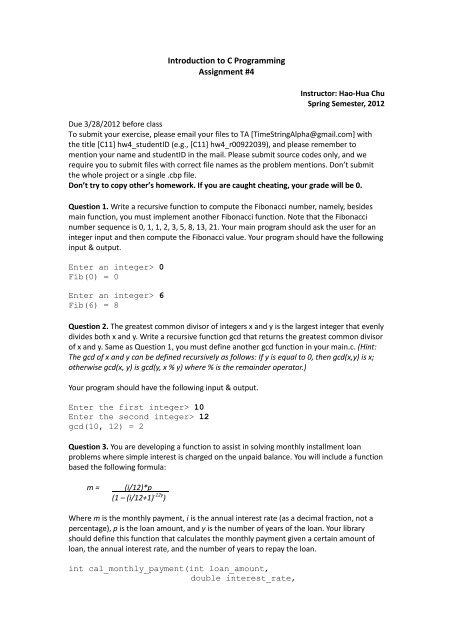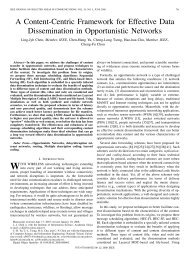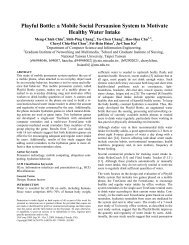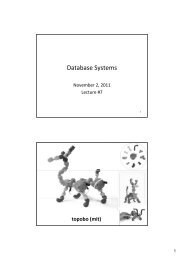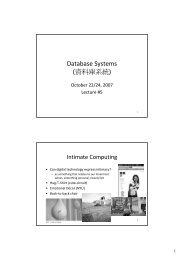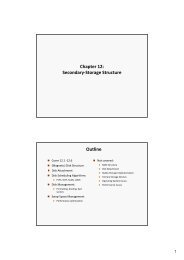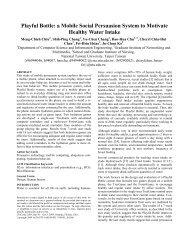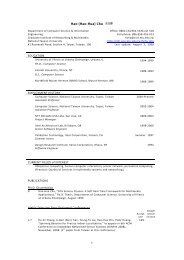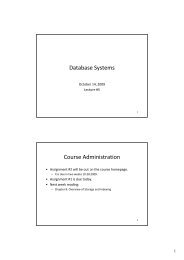Introduction to C Programming Assignment #4
Introduction to C Programming Assignment #4
Introduction to C Programming Assignment #4
Create successful ePaper yourself
Turn your PDF publications into a flip-book with our unique Google optimized e-Paper software.
<strong>Introduction</strong> <strong>to</strong> C <strong>Programming</strong><br />
<strong>Assignment</strong> <strong>#4</strong><br />
Instruc<strong>to</strong>r: Hao-Hua Chu<br />
Spring Semester, 2012<br />
Due 3/28/2012 before class<br />
To submit your exercise, please email your files <strong>to</strong> TA [TimeStringAlpha@gmail.com] with<br />
the title [C11] hw4_studentID (e.g., [C11] hw4_r00922039), and please remember <strong>to</strong><br />
mention your name and studentID in the mail. Please submit source codes only, and we<br />
require you <strong>to</strong> submit files with correct file names as the problem mentions. Don’t submit<br />
the whole project or a single .cbp file.<br />
Don’t try <strong>to</strong> copy other’s homework. If you are caught cheating, your grade will be 0.<br />
Question 1. Write a recursive function <strong>to</strong> compute the Fibonacci number, namely, besides<br />
main function, you must implement another Fibonacci function. Note that the Fibonacci<br />
number sequence is 0, 1, 1, 2, 3, 5, 8, 13, 21. Your main program should ask the user for an<br />
integer input and then compute the Fibonacci value. Your program should have the following<br />
input & output.<br />
Enter an integer> 0<br />
Fib(0) = 0<br />
Enter an integer> 6<br />
Fib(6) = 8<br />
Question 2. The greatest common divisor of integers x and y is the largest integer that evenly<br />
divides both x and y. Write a recursive function gcd that returns the greatest common divisor<br />
of x and y. Same as Question 1, you must define another gcd function in your main.c. (Hint:<br />
The gcd of x and y can be defined recursively as follows: If y is equal <strong>to</strong> 0, then gcd(x,y) is x;<br />
otherwise gcd(x, y) is gcd(y, x % y) where % is the remainder opera<strong>to</strong>r.)<br />
Your program should have the following input & output.<br />
Enter the first integer> 10<br />
Enter the second integer> 12<br />
gcd(10, 12) = 2<br />
Question 3. You are developing a function <strong>to</strong> assist in solving monthly installment loan<br />
problems where simple interest is charged on the unpaid balance. You will include a function<br />
based the following formula:<br />
m = (i/12)*p<br />
(1 – (i/12+1) -12y )<br />
Where m is the monthly payment, i is the annual interest rate (as a decimal fraction, not a<br />
percentage), p is the loan amount, and y is the number of years of the loan. Your library<br />
should define this function that calculates the monthly payment given a certain amount of<br />
loan, the annual interest rate, and the number of years <strong>to</strong> repay the loan.<br />
int cal_monthly_payment(int loan_amount,<br />
double interest_rate,
int loan_years);<br />
In addition, in your main function, print a table for a loan by displaying in columns the<br />
payment number, the monthly payment, the interest paid, the loan repaid, and the loan<br />
balance. The last payment must be calculated separately.<br />
Enter the loan amount> 10000<br />
Enter the annual interest rate> 0.05<br />
Enter the loan years> 2<br />
PaymentID MonthlyPayment InterestPaid LoanPaid LoanBalance<br />
… (display as follows)


